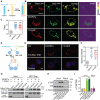Receptor-targeting nanomaterials alleviate binge drinking-induced neurodegeneration as artificial neurotrophins
- PMID: 37366469
- PMCID: PMC10291571
- DOI: 10.1002/EXP.20210004
Receptor-targeting nanomaterials alleviate binge drinking-induced neurodegeneration as artificial neurotrophins
Abstract
The distinguished properties of nanomaterials promote us to explore whether their intrinsic activities would be beneficial to disease treatment. Furthermore, understanding the molecular mechanism is thereby crucial for biomedical applications. Here, we investigate the therapeutic effects of single-walled carbon nanotubes (SWNTs) in a rat model of binge alcohol-induced neurodegeneration. With selection from four types of SWNT structures, bundled SWNTs (bSWNTs) facilitated the recovery of learning and memory via enhancing neuroprotection and neuroregeneration. We screened the potential target for bSWNTs, and found that bSWNTs have the abilities to directly interact with neurotrophic receptors, especially tropomyosin-related kinase B (TrkB). Moreover, similar to the actions of endogenous neurotrophins, bSWNTs could trigger the dimerization and phosphorylation of TrkB, while these conformational changes resulted in activating their downstream signals involved in neuroprotection and neuroregeneration. With relatively clear mechanisms, these "artificial neurotrophins" provide a proof-of-concept example as an efficiently therapeutic strategy for the treatment of neurodegenerative diseases.
Keywords: artificial neurotrophins; binge drinking; carbon nanotubes.
© 2021 The Authors. Exploration published by Henan University and John Wiley & Sons Australia, Ltd.
Conflict of interest statement
The authors declare that they have no conflict of interest.
Figures





References
LinkOut - more resources
Full Text Sources
